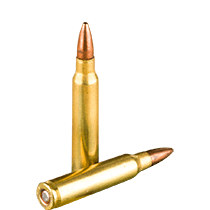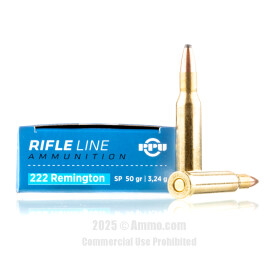
222 Ammo For Sale
Overview of 222 Ammo
The .222 Remington was introduced shortly after World War II and was the first new cartridge of the era presented by a large manufacturer. A unique characteristic about this round is that the case is original, instead of modifying an existing case to become the new caliber. However, since the .222 was introduced, it has inspired many other successful cartridges – including the .17 Remington, .221 Fireball, and the .223 Remington. The last of these has largely eclipsed the 222 for dropping varmints, as rounds produced by the American military tend to perform a lot better than their civilian counterparts.
222 Ballistics: Chart of Average 222 Ballistics
Note: This information comes from the manufacturer and is for informational purposes only. The actual ballistics obtained with your firearm can vary considerably from the advertised ballistics. Also, ballistics can vary from lot to lot with the same brand and type load.
| 222 Bullet WEIGHT | Muzzle VELOCITY (fps) | Muzzle ENERGY (ft. lbs.) | TRAJECTORY (in.) | |||||||||
|---|---|---|---|---|---|---|---|---|---|---|---|---|
| Muzzle | 100 yds. | 200 yds. | 300 yds. | Muzzle | 100 yds. | 200 yds. | 300 yds. | 100 yds. | 200 yds. | 300 yds. | 400 yds. | |
| 35 Grain | 3760 | 3125 | 2574 | 2085 | 1099 | 759 | 515 | 338 | 1 | 0 | -6.3 | -20.8 |
| 40 Grain | 3600 | 3117 | 2673 | 2269 | 1151 | 863 | 634 | 457 | 1.07 | 0 | -6.13 | -18.9 |
| 40 Grain Magnum | 3600 | 3140 | 2726 | 2347 | 1150 | 876 | 660 | 489 | 1 | 0 | -5.7 | -17.8 |
| 50 Grain | 3140 | 2602 | 2123 | 1700 | 1094 | 752 | 500 | 321 | 2 | -0.4 | -11 | -33 |
| 50 Grain | 3345 | 2930 | 2553 | 2205 | 1242 | 953 | 723 | 540 | 1.3 | 0 | -6.7 | -20.6 |
| 50 Grain Magnum | 3340 | 2917 | 2533 | 2179 | 1238 | 945 | 712 | 527 | 1.3 | 0 | -6.8 | -20.9 |
| 55 Grain | 3020 | 2562 | 2147 | 1773 | 1114 | 801 | 563 | 384 | 2 | -0.4 | -11 | -33 |
| 55 Grain Magnum | 3240 | 2748 | 2305 | 1906 | 1282 | 922 | 649 | 444 | 2 | -0.2 | -9 | -27 |
Customer Reviews
-
Lyman said:
very pleased and prompt fast delivery would recomend to everyone

















